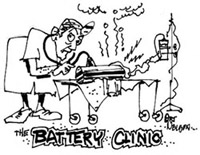Soldering to Ni-Cds is not a good idea. Try to use the welded tabs and solder to those if at all possible. Soldering
to the positive button will have a very high probability of destroying the nylon seal. You just can't get the button hot
enough to get a good solder joint without compromising the integrity of the nylon seal ring. This ring is under compression
and raising its temperature will allow it to relax and the sealing properties are history.
If you can hold a penny
between two fingers long enough to get a good solder joint with #18 stranded wire or braid, then go ahead and solder to your
cells, otherwise get cells with solder tabs. Remember, nylon is a good insulator, electrical and thermal. There is no thermal
path for the soldering heat to dissipate when heat is applied to the cover button of a cell.
Nylon characteristics:
Nylon has its glass transition at 460°F - 500°F . The maximum use temperature of nylon 6-6 parts is about
300°F. (Note that this is considerably below the glass transition temperature.)
Soldering temperatures are in the
450°F to 650°F range.
I realize this flies in the face of all the electric flight “experts” that
assemble their own packs but it is never the less fact.
You have never seen a pack assembled by a cell manufacturer
or any other pack manufacturer (outside of the hobby market) where connections are soldered directly to a cell. There
is a reason.
C. L. Scholefield
Manager (retired) Battery Design and Application Engineering
General Electric
Battery Business Department
Gates Energy Products
Energizer Power Systems
Sanyo Cadnica Sealed Type Nickel-Cadmium
Batteries Engineering Handbook
SF-9785ND
Section 10 General Remarks and Precautions
5 Safety Insturctions
(page 48)
"Never solder lead wire directly to Cadnica battery terminals. Soldering heat may damage the safety vent
in the positive cap after a terminal plate is spot-welded on the battery terminal, solder a lead wire on it."
Sanyo
Twicell Sanyo Nickel-Metal Hydride Rechargeable Batteries Engineering Handbook SF-9787ND
Section 5 Important Cautions
for Handling
Batteries 5-3-3 Do Not Misuse Batteries - "Never solder a lead wire or plate directly to Twicell batteries.
The heat generated by the soldering may melt the insulation, damage the gas release vents or protective devices, cause leakage
of battery fluid, heat generation, bursting or fire."
General Electric Nickel Cadmium Battery Application Manual
[Library of Congress Cat Card No 86-80684
Section 6.5.3 9 (page 6-20)
"Never solder directly to the nickel-cadmium
cells, only to solder tabs or wire leads.A hot soldering iron placed directly on the cell is likely to cause seal ring and
vent seal damage as well as damage to the separator systems."
First let me say that I am not on a
crusade to stop the modeling world from soldering directly to cells in construction of packs. All that I'm trying
to do is to alert modelers that there are some caveats they should consider in making the decision to solder or not.
In
the electric propulsion application and particularly on the competitive side, the reduction of pack resistance plays a key
role in obtaining maximum performance. Direct soldering has been found as one means to achieve this.
Soldering directly
to cells that are destined for flight control operation is not justified and can compromise the reliability of the packs.
These packs are frequently hidden away in the plane and are not frequently available for inspection for any leakage and corrosion
that may have resulted from damage to seals/vents from direct soldering that can compromise the reliability of the control
system.
The risk (safety-wise) of soldering directly to cells is minimal but quite dramatic on the rare occasion that
it does surface. There are probably more "incidents" resulting from abusive charge regimes than from actually soldering.
Of course the question always comes up was the soldering contributory to the ultimate cell burst?
As far as warnings
on the product as sold through hobby channels one has to consider that no cell manufacture cells directly to the public. Sales
are through one or more levels of distribution, original equipment manufacturer or pack assembler. It is the responsibility
of the cell manufacturer to inform the OEM or pack assembler of possible hazards in assembly. This is done quite adequately
in the engineering handbooks made available by the cell manufacturer. If the OEM or pack assembler chooses
to ignore
them, or passes cells on to the end user without informing him, that becomes his responsibility.
Fortunately
the hobby market is infinitesimal compared to the overall market for batteries make risk exposure equally infinitesimal to
the cell manufacturer and further insulated by one or more layers of distribution. This is not to say that the cell manufacturer
cannot be held responsible. In several cases I have been involved in as an expert witness (with TASA)
the cell manufacturer
has been able to show due diligence in conveying information to the OEM or pack assembler so that they were not held liable
for misapplication of the product by the end user. This "minimal risk exposure" is probably the only reason why
a major industrial manufacturer (like Futaba/OS) even messes with the hobby - can you think of anything more dangerous than
a model engine with an exposed APC prop? I just tells you how insignificant this hobby is in the overall scheme of product
liability.
One classic case, where the OEM did not make adequate provisions (due diligence again) for preventing
a battery from being inserted in a string in reverse the resulting cell leakage (an alkaline primary cell in this case)
and caustic burns to the child did not result in the cell manufacture having to pay - it was the OEM that took the hit.
Bottom
line: Soldering directly to cells is not recommended. Do it understanding the risks and possible trade offs to performance,
safety and reliability.
I hope this the end of this discussion (for now).
Red S. AMA 951
Red's
R/C Battery Clinic
12/2001

